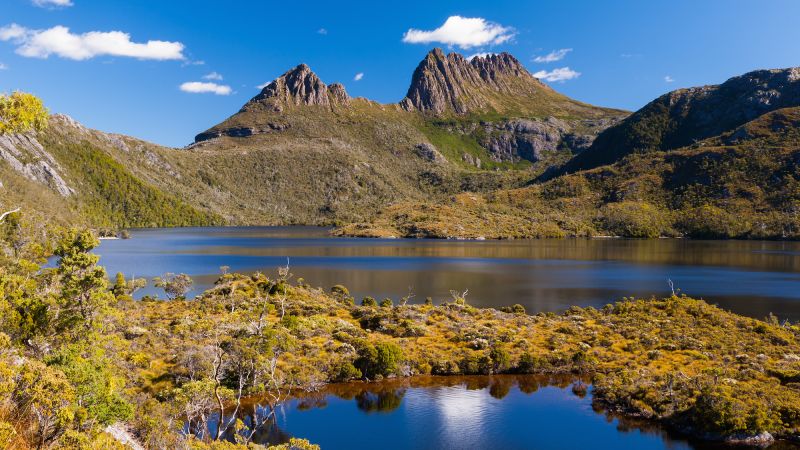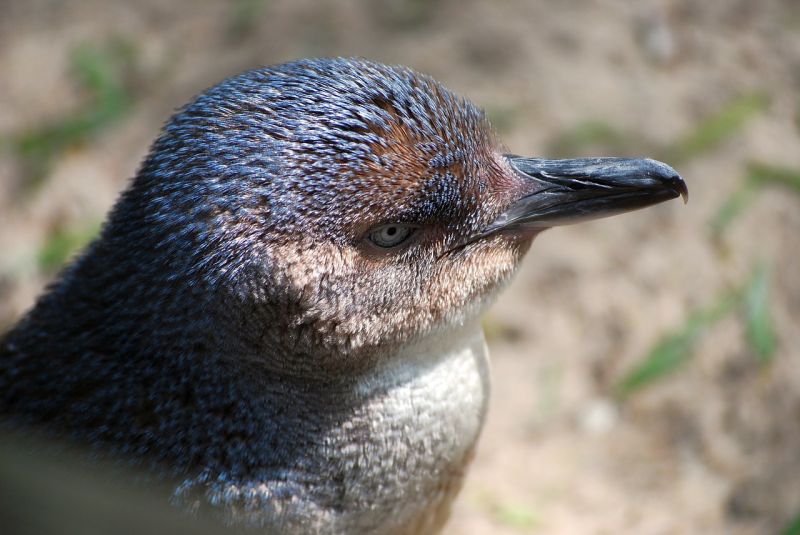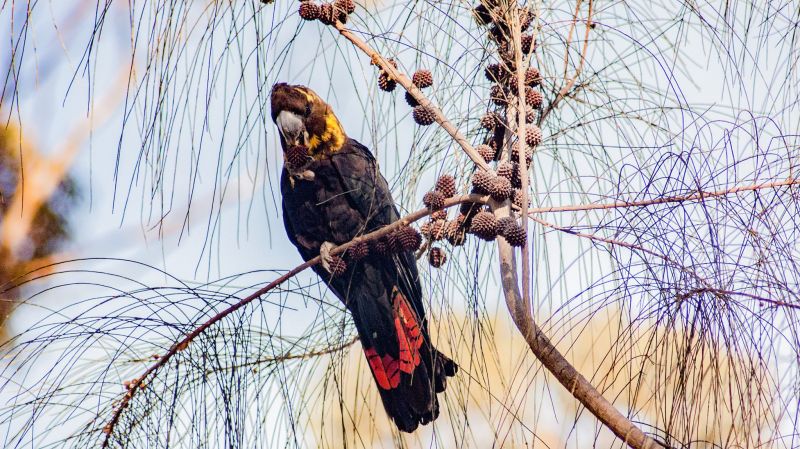Premium Tasmania & Kangaroo Island Package
Duration: 13 days/ 12 nights with Tasmanian Odyssey
Regions: 8 days Tasmania, Kangaroo Island
Price: From £5,699*
To book today, please contact:
email: susie@tasmanianodyssey.com
phone: + 44 (0) 1534 735449
Discover two of Australia’s most adored and biodiverse island destinations in supreme comfort with premium lodgings, outstanding food and wine and expert guides. Stunning coastal formations, alpine vistas, eucalypt groves, pristine wetlands, and World Heritage Listed rainforests provide access to numerous endemic birds and sub-species, including the Glossy-black Cockatoo, Forty-spotted Pardalote, Tasmanian Wedge-tailed Eagle, Orange-bellied Parrot and a host of Australia’s most adored marsupials including Tasmanian Devils, quolls, wallabies, pademelons and Koalas.
Highlights include an eight day voyage across Tasmania’s most beloved wilderness areas, including visits to the world- renowned Cradle Mountain, Freycinet, Maria Island and Mt Field National Parks along with the renowned Southwest World Heritage Area. A three day tour of world-renowned Kangaroo Island provides the opportunity to spot over 260 species, almost one-third of Australia’s bird count along with the Short- beaked Echidna and endangered Australian Sea-lion.
Day 1: Launceston to Cradle Mountain
Be met today by our local guide at midday at the Launceston Transit Centre and start your journey to UNESCO World Heritage Listed Cradle Mountain National Park. Visit the fascinating Marakoopa Caves before continuing to Cradle Mountain. Enjoy an introduction to this captivating alpine environment before settling in at your accommodation for the night.
Accommodation: Cradle Mountain Hotel (Standard room or similar)
Day 2: Cradle Mountain and Dove Lake
Today you will be mesmerised by the beautiful alpine landscapes of Cradle Mountain, where in many places, dolerite cracked into vertical columns has resulted in spectacular sculpted mountains and cliffs. Your guide will introduce you to the many endemic fauna and flora species of the region whilst enjoying picturesque views on your walk beneath the spectacular craggy peaks of Cradle Mountain. Magical forests of Pandani (the tallest heath plant in the world), Sassafras, King Billy Pines and the deciduous Beech can be seen adjacent to spectacular glacial lakes.
Birds such as Forest Ravens, Black Currawongs, Green Rosellas and Wedge-tailed Eagles are seen in this area, whilst Common Wombats, Tasmanian Pademelons, Short-beaked Echidnas, Platypus, Spotted-tailed Quoll and the Eastern Quoll may also be seen. In the evening, you have the option to join your guide on a night spotlighting tour or simply relax at your accommodation.
Accommodation: Cradle Mountain Hotel (Standard room or similar)

Day 3: Cradle Mountain
Depart the Cradle Valley and travel to Tasmania’s Central Highlands also known as “The Heart of Tasmania”. Here in this alpine environment, the air is noticeably clear and the silence inspiring. In the afternoon, there is an opportunity to explore Lake Ada, discover its history and immerse yourself in this barren but beautiful and unique landscape. On dusk you will have the chance to observe Common Wombats, Bennett's Wallabies and possums as they turn the area into a hub of activity. With a bit of luck you may also see quolls and the iconic Tasmanian Devils in their natural habitat.
Accommodation: Thousand Lakes Lodge

Day 4: East Coast & Bicheno
This morning takes you from the Tasmanian highlands and into the quaint midlands town of Campbell Town for lunch. The group will depart for the East Coast, with its exceptional beauty, pristine white sandy beaches and granite coastline. Birders will enjoy regular sightings of Australian Pelicans, Crested Terns, Little Pied Cormorants, Black-headed honeyeaters, Silvereyes and Superb Fairy-wrens and sometimes Beautiful Firetails and Hooded Dotterels. The day’s journey concludes at the gorgeous seaside village of Bicheno where guests will enjoy a Tasmanian Devils after dark experience to observe and learn about the island’s most iconic resident. Continue to Tasmania’s East Coast.
Accommodation: Beachfront at Bicheno, Standard (or similar)
Day 5: Freycinet National Park and Wineglass Bay
Today, guests will take a journey into the exquisite beauty of the Freycinet Peninsula on The Wineglass Bay Cruise. This region is largely made up of a orthoclase-rich granite which gives the mountains and coastline a characteristic gorgeous pink tint, flanked by and native forest edged by crystal blue bays.
Wildlife is abundant in this area with opportunities to see Bennett's Wallabies, Tasmanian Bettongs, echidnas, Common Wombats, White-bellied Sea Eagles, dolphins, Australian Fur Seals, Crested Terns, Australasian Gannets, Flame Robins and Superb Fairy-wrens are often observed in the area.
You will have the rare opportunity to experience Wineglass Bay from the water with its shimmering crescent of white sand fringing the edge of a perfect turquoise sea. In the afternoon, there will be time do a short cliff-top walk around the lighthouse at Cape Tourville. In the evening, a night tour offers you the rare chance to observe Little Penguins, tumble form the ocean and waddle up the sand to their nesting burrows.
Accommodation: Beachfront at Bicheno (Standard or similar)
Day 6: Maria Island
This morning, travel to the seaside village of Triabunna and board a ferry to cross the Mercury Passage to Maria Island. This unique island national park sits just off Tasmania’s east coast. Enjoy a day of peaceful walking along historic ruins, sweeping bays, rugged fossil cliffs and imposing mountains.
This island sanctuary provides an opportunity to view its resident wildlife, including Common Wombats, Cape Barren Geese, Tasmanian Pademelons, Forester Kangaroos, Bennett;s Wallabies. In the afternoon, guests will travel down the east coast into Tasmanian’s capital city, Hobart.
Accommodation: Hotel Grand Chancellor (Mountain View or similar)

Day 7: Mt Field National Park
You will be met by your guide this morning before venturing into Mount Field National Park, the oldest National Park in the state. Be mesmerised by the lush forest landscapes from eucalyptus temperate rainforest to alpine moorland. Your guide will provide interpretation along the rainforest walks with the opportunity to see some of the tallest trees in the world.
This cool temperate rainforest allows you the opportunity to search for some of Tasmanians 12 endemic bird species including Scrbutit, Black currawong and Tasmanian thornbill. After lunch, you will have an opportunity to observe the unique duck bill and webbed feet Platypus in the wild. This semiaquatic, egg-laying, mammal is endemic to eastern Australia including Tasmania and is a recognizable and iconic symbol of Australia.
Complete the day with a visit to Bonorong Wildlife Sanctuary to experience Tasmanian Devils, Wombats, Wallabies, Quolls and other furry Australian animals first hand and learn about their rehabilitation and rescue efforts.
Accommodation: Hotel Grand Chancellor (Mountain View or similar)

Day 8: Southwest World Heritage Area
This morning’s journey will give you a feel of the extensive wilderness Tasmania has to offer. Board a scenic flight to Tasmania’s spectacular and pristine Southwest Wilderness. Experience the peace and tranquillity of this majestic setting where mountain peaks give way to buttongrass plains that meet the wild Southern Ocean (weather dependent). For those visiting between October and March there is an opportunity to spot the endangered Orange-bellied Parrot, ranked one of the world’s rarest and most endangered species. This tour concludes in Hobart between 1:30pm and 3pm weather depending*.
* If weather conditions do not allow the Southwest flight to go ahead, a poor weather option is available. This includes the Pennicott Wilderness Journeys Tasman Island Cruise. Enjoy the stunning 3 hour Tasman Island Cruise. This adventure cruise manoeuvres around small islands, into sea caves, and undersea cliffs soaring 300m above the Tasman Sea. You may have the opportunity to see albatross, dolphins and whales which frequent this pristine coastline. In the afternoon, return to Hobart.
Day 9: Hobart to Adelaide
In the morning, you will take an airport transfer by Premier Travel Tasmania from Salamanca Place to Hobart Airport, to travel to Adelaide.(flights/transfer - own arrangements)
Accommodation – Adelaide (city central, room only)
Day 10: Kangaroo Island
Kangaroo Island is a birdwatcher's paradise, with the opportunity to spot over 260 birds, almost one-third of Australia's bird count. Over 90% of the Island is mallee and woodland, with beautiful Eucalyptus groves, shrublands, fernlands and forests. The island is blessed with amazing protected coves and beaches through to rugged cliffs, providing abudant opportunities to spot seabirds, waterbirds and waders.
Upon flying into Kangaroo Island, guests will be greeted by an Island guide. The first stop is Duck Lagoon – a freshwater billabong where typical encounters include: White-eared, White-naped and Brown-headed Honeyeaters; Crimson Rosellas; Superb Fairy-wrens; Black Swans; Grey and Chestnut Teals; Yellow-billed Spoonbills; Pacific Black Ducks; Australasian and Hoary-headed Grebes; Chestnut-breasted Shelducks; Little Pied Cormorants; and (seasonally) Freckled Ducks. After enjoying a delicious morning tea, guests will venture to Roper’s Gums – a tall Eucalyptus forest where guests will learn about the the endemic Glossy Black Cockatoo recovery plan.
After viewing the beautiful headwaters of Cygnet River, guests will arrive at a private lunch site and a seafood barbeque lunch. This area is home to Koalas; Crescent & New Holland Honeyeaters; Eastern Spinebills; Grey Fantails; Rainbow and Purple-crowned Lorikeets; Yellow-tailed Black Cockatoos and a selection of smaller bush birds. After lunch, travellers will explore Lathami Conservation Park, which protects the habitat of the Glossy Black Cockatoo. In this area, it is common to encounter Kangaroo Island Kangaroos; Tammar Wallabies; Scarlet Robins; Brown Thornbills; Grey Shrike Thrush; Short-beaked Echidnas; Golden Whistlers; and Beautiful Firetails. Ending the day at the gorgeous Stokes Bay, guests will enjoy the opportunity to spot Australian Pelicans; Eastern Reef Herons, Hooded Plovers and White-bellied Sea-eagles, before arriving to American River.
Mercure Kangaroo Island Lodge (dinner/bed/breakfast)
Day 11: Kangaroo Island
Guests will have the option of an early morning birding excursion in the bush adjacent to the hotel or along the American River shoreline. Glossy Black Cockatoos are frequent encounters, as are Grey Currawongs, Little Corellas, Galahs and Black-faced Cuckoo-shrikes. Along the shorelines, there are often Pied Oystercatchers, Royal Spoonbills, Black Swans, Grey Teals, Australian White Ibis and Australian Pelicans. Rufous Night Herons often roost in the large pines opposite the fire station. Guests will arrive back to the hotel for breakfast before departing at 8:30am.
During the drive to Seal Bay, the first main destination for the day, guests should look out for Raptors. Possibilities include Wedge-tailed Eagles, Swamp Harriers, Australian Kestrels, Black-shouldered Kites and Brown Falcons. At Seal Bay, guests will enjoy a private guided Australian sea-lion experience. The sea-lions share the beach with Caspian and Crested Tern, Sooty Oystercatchers and Hooded Plovers. Overhead, it is common to see White-bellied Sea Eagles and Ospreys. The headland to the west is a prime habitat for Great and Pied Cormorants.
Next is Point Ellen where seasonal encounters include Rock Parrots, Fairy Terns and Little Penguins can sometimes be found in burrows near the beacon. During morning tea, guests will keep an ear out for Southern Emu-wrens, Purple-gaped Honeyeaters and Western Whipbirds in the heath and mallee. The massive wilderness expanses of Flinders Chase National Park is the focus for the rest of the day, starting with the Rocky River precinct. Encounters here can include Cape Barren Geese, Crescent Honeyeaters, Little and Red Wattlebirds, Striated and Spotted Pardalotes, Australian Ravens, Koalas, Kangaroo Island Kangaroos, Short-beaked Echidnas, Rosenberg’s Goanna (seasonal) and Tammar Wallabies.
Next is the iconic Remarkable Rocks, a spectacular natural sculpture on the clifftops. Here the group can have a picnic lunch – looking out for Australian Kestrels, Tawny-crowned Honeyeaters, and another chance to try for Southern Emu-wren and the elusive Western Whipbird. Nearby on the cape is Admiral’s Arch – a sea cave which often turns up Australian Ravens, Sooty Oystercatchers, Crested Terns (which have had Antarctic terns amongst them in 2006 and 2007), Pacific Gulls.
If a south-westerly wind is blowing, there is a chance to see some pelagic species. If time permits, guests will have the option to visit “Grassdale” in Kelly Hill Conservation Park, providing abundant opportunities to see kangaroos in the wild, plus a range of bird habitats.
Mercure Kangaroo Island Lodge (dinner/bed/breakfast)

Day 12: Kangaroo Island
There is an option to take another early morning birding walk as per the previous day, with a 8:15am departure from American River. This morning, guests will go out on the ocean on a boat to get a close look at the Busby Islet. The group will observe numerous birds from the sea, as this is a prohibited area to protect breeding Australian Pelicans, Royal Spoonbills, Black-faced and Pied cormorants, Australian White Ibis and potentially many other species including international migratory species seasonally (Nov – Mar). White-bellied Sea Eagles constantly harass the nesting birds, providing an excellent chance to see Black Swans and chance encounters with Bottle-nosed Dolphins.
Guests will have lunch at Reeves Point, providing a chance to learn about the settlement history of the island and often turns up quite a few birds – depending on the season. After lunch, a visit the Kingscote Oxidation Pond provides the opportunity to spot a good cross-section of waterfowl on the ponds and the adjacent Cygnet River Estuary is always worth a look. The afternoon includes a visit to D’Estrees Bay (Hooded Plovers, Ruddy Turnstones (seasonally), Ospreys, Rock Parrots (seasonally) and a quick look at one of the MacGillivray Wetlands on the way back to the airport if time permits. Guests will take a flight to Adelaide.
Accommodation –Adelaide (city central, room only)
Day 13:
Depart Adelaide (own arrangements)
To book today, please contact:
email: susie@tasmanianodyssey.com
phone: + 44 (0) 1534 735449
*Rates are per person, twin share based on 2 people travelling. Costs valid to 31 March 2019 – and subject to availability at time of booking and currency fluctuations. No airfares included, except ADL/KGC & KGC/ ADL. Tasmanian Odyssey is fully bonded and offers full financial protection for customers.

